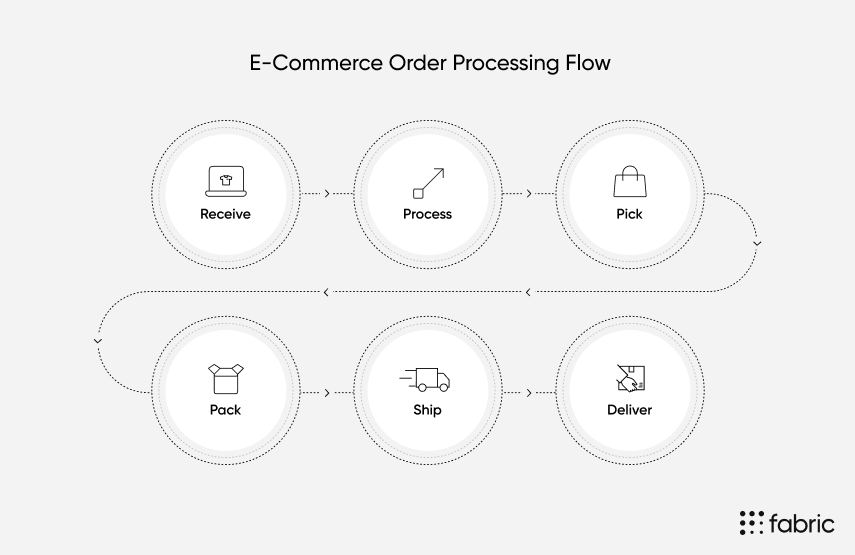Which E-Commerce Order Processing Solution Is Scalable?

When a company decides to switch to an e-commerce order processing solution that is versatile enough to scale alongside its business, there are three main reasons why:
- Antiquated manual systems have reached the limits of their capabilities, and the cost of employing order management specialists to process orders manually no longer makes sense.
- The company is looking to complement its enterprise resource planning (ERP) system and requires a more robust and customizable solution to improve existing workflows from order placement to delivery.
- The company is a high-growth business that’s expanding to omnichannel fulfillment and requires an order processing solution that’s capable of fulfilling and shipping inventory from anywhere.
If you’re an e-commerce manager that’s frustrated with current systems or outdated software, it may be time to consider a different approach to order processing. An order management system (OMS) powered by application programming interfaces (APIs) offers the flexibility, efficiency, and scalability that businesses need to streamline operations, optimize costs and delivery, and improve order processing.
[toc-embed headline=”Order Processing Basics”]
Order Processing Basics
Overview
The COVID-19 pandemic has drastically changed consumer behavior and accelerated e-commerce adoption by an estimated ten years. As a result, customers today expect fast and reliable delivery when they place their orders online. A recent study found that 95% of shoppers consider fast delivery options a significant factor when making a purchase. To meet these heightened expectations, businesses can speed up the fulfillment process by improving the order processing workflow.
What is order processing?
Order processing, also known as sales order processing or order management processing, is the series of steps that a business follows to fulfill a customer’s purchase in a fast, efficient manner. The moment a customer clicks the buy button on a website or initiates a purchase on a different sales channel, it triggers a complex chain of communications that involves multiple services within an organization.
How e-commerce order processing works
The typical workflow for order processing in e-commerce follows some variation of the following sequence:
- The customer places an order on an e-commerce site, mobile app, or other digital sales channel.
- The payment is validated through a payment gateway like PayPal, Stripe, or Square, and the company records and accepts the order through their OMS.
- The warehouse receives the order from the OMS or warehouse management system (WMS).
- The product is picked, packed, and shipped. This step can be completed in-house or by a third-party logistics (3PL) provider or dropshipper.
- The order is delivered to the customer.
- If the customer wants to return the order, a refund and return process is initiated.

The current state of order processing
Many businesses use manual processes that rely on paperwork and spreadsheets to centralize order fulfillment, manage inventory, and manage returns. Unfortunately, these systems often limit a merchant’s ability to expand their product base and scale supply across multiple sales channels. They are also time-consuming, resource-intensive, and prone to human error, which can lead to fulfillment delays.
Manual order processing also costs more. Companies that rely primarily on paper-based protocols tend to incur much higher costs than companies that have moved to electronic solutions for capturing customer orders. For example, one study found that a cloud-based order processing system incurred a cost of $2.00 per sales order while a paper-based system incurred a cost of $7.00 per sales order.
The ideal state of order processing
An alternative to a manual system is an automated system that uses order management software and APIs. These technical tools empower e-commerce merchants to facilitate end-to-end order fulfillment with much higher efficiency and better accuracy. Each order is 100% electronic and fully visible throughout its lifecycle. With the right OMS and accompanying APIs, a company can process orders expeditiously to create a seamless post-purchase experience for the customer.
[toc-embed headline=”Scaling E-Commerce Order Processing”]
Scaling E-Commerce Order Processing
Using an OMS
Not all order management systems are created equal. For small businesses with limited order volume, an OMS that’s part of a monolithic platform like Shopify Plus may be all that’s needed. However, a more scalable OMS is designed to generate a holistic, centralized, 360-degree view of customer orders and available inventory across all sales channels, fulfillment centers, and customer service channels.
A microservices-based and API-first platform is today’s only scalable solution that offers omnichannel fulfillment capabilities, faster order processing, better accuracy, greater visibility and control, higher productivity, and better inventory management, which ultimately leads to a superior post-purchase experience for the customer. Trying to recreate this level of service with a manual system or with an outdated OMS may be difficult at scale.
Using Order APIs
Modern OMS software can improve order processing by using application programming interfaces (APIs) to create real-time connections across the e-commerce tech stack.
Order APIs can be used to add shipment details, cancel orders, check order status, initiate checkouts with different payment gateways, split payments between payment methods, and retrieve orders by details like order ID, authorization token, and email. They also integrate with warehouse management and shipping systems and can connect to third-party logistics (3PL) and dropship providers as well.
For example, if a storefront needed to cancel an individual order, they could use a PATCH https://{baseurl}/api-order/orders/cancel API endpoint to send an API request that would look like this:
{
"orderId": "8568-9704-74294",
"cancellationCode": "2001"
}
Inventory APIs are powerful tools to improve inventory management systems. They can be used to create inventory items, search for items, increase or decrease inventory amounts in bulk, retrieve inventory information, and update inventory items in bulk.
For example, if a company wanted to add one or multiple items to their inventory, they could use the POST https://{baseurl}/inventory/bulk-insert endpoint to send an API request that would look like this:
[
{
"sku": "123456",
"totalQuantity": 30003,
"reservedQuantity":0,
"locationId": 104,
"type": "Stock",
"channelId": 12
},
{
"itemId": "1000000213",
"totalQuantity": 10000,
"reservedQuantity":0,
"locationId": 104,
"type": "Transit",
"channelId": 12,
"transitOrderDate": "2020-05-05",
"transitStockDate": "2020-05-05",
"transitRef": "WO-20000"
}
]
[toc-embed headline=”Key Takeaways”]
Key Takeaways
- To scale order processing operations, switch from manual to fully automated order processing with order management system (OMS) software.
- An OMS that’s part of a rigid e-commerce architecture like Shopify Plus does not offer the same benefits as an OMS that’s part of a microservices-based and API-first platform.
- A standalone OMS powered with application programming interfaces (APIs) offers the flexibility, efficiency, and scalability that businesses need to streamline operations, optimize costs and delivery, and improve order processing.
- fabric OMS allows businesses to connect orders, inventory, and warehouses to deliver products as fast as possible and create a seamless post-purchase experience for the customer.

Product @ fabric. Previously @ EMAAR NEXT, Groupon, and NorAm International Partners.